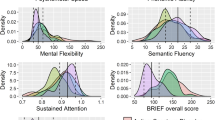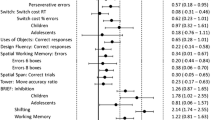Abstract
Although executive functioning (EF) difficulties are well documented among children and adolescents with autism spectrum disorder (ASD), little is known about real-world measures of EF among adults with ASD. Therefore, this study examined parent-reported real-world EF problems among 35 adults with ASD without intellectual disability and their correlations with adaptive functioning and co-morbid anxiety and depression symptomatology. A variable EF profile was found with prominent deficits occurring in flexibility and metacognition. Flexibility problems were associated with anxiety-related symptoms while metacognition difficulties were associated with depression symptoms and impaired adaptive functioning (though the metacognition-adaptive functioning relationship was moderated by ADHD symptoms). These persistent EF problems are predictors of broader functioning and therefore remain an important treatment target among adults with ASD.

Similar content being viewed by others
References
Achenbach, T. M., & Rescorla, L. A. (2003). Manual for the ASEBA adult forms & profiles. Burlington, VT: University of Vermont, Research Center for Children, Youth, & Families.
Ambery, F. Z., Russell, A. J., Perry, K., Morris, R., & Murphy, D. G. (2006). Neuropsychological functioning in adults with Asperger syndrome. Autism, 10, 551–564. doi:10.1177/1362361306068507.
Ashwood, K. L., Tye, C., Azadi, B., Cartwright, S., Asherson, P., & Bolton, P. (2015). Brief report: Adaptive functioning in children with ASD, ADHD and ASD + ADHD. Journal of Autism and Developmental Disorders, 45, 2235–2242. doi:10.1007/s10803-014-2352-y.
Barnard, L., Muldoon, K., Hasan, R., O’Brien, G., & Stewart, M. (2008). Profiling executive dysfunction in adults with autism and comorbid learning disability. Autism, 12, 125–141. doi:10.1177/1362361307088486.
Blijd-Hoogewys, E. M., Bezemer, M. L., & van Geert, P. L. (2014). Executive functioning in children with ASD: An analysis of the BRIEF. Journal of Autism and Developmental Disorders, 44, 3089–3100.
Cannon, L., Kenworthy, L., Alexander, K. C., Werner, M. A., & Anthony, L. G. (2011). Unstuck and on target! An executive function curriculum to improve flexibility for children with autism spectrum disorders. Baltimore, MD: Paul H. Brookes.
Damasio, A. R., & Maurer, R. G. (1978). A neurological model for childhood autism. Archives of Neurology, 35, 777–786.
Developmental Disabilities Monitoring Network Surveillance Year 2010 Principal Investigators; Centers for Disease Control and Prevention (CDC). (2014). Prevalence of autism spectrum disorder among children aged 8 years—Autism and developmental disabilities monitoring network, 11 sites, United States, 2010. MMWR Surveillance Summaries, 63, 1–21.
Geurts, H. M., & Vissers, M. E. (2012). Elderly with autism: Executive functions and memory. Journal of Autism and Developmental Disorders, 42, 665–675. doi:10.1007/s10803-011-1291-0.
Gilotty, L., Kenworthy, L., Sirian, L., Black, D. O., & Wagner, A. E. (2002). Adaptive skills and executive function in autism spectrum disorders. Child Neuropsychology, 8, 241–248.
Goldstein, G., Minshew, N. J., Allen, D. N., & Seaton, B. E. (2002). High-functioning autism and schizophrenia a comparison of an early and late onset neurodevelopmental disorder. Archives of Clinical Neuropsychology, 17, 461–475.
Gotham, K., Bishop, S. L., Hus, V., Huerta, M., Lund, S., Buja, A., et al. (2013). Exploring the relationship between anxiety and insistence on sameness in autism spectrum disorders. Autism Research, 6, 33–41. doi:10.1002/aur.1263.
Granader, Y., Wallace, G. L., Hardy, K. K., Yerys, B. E., Lawson, R. A., Rosenthal, M., et al. (2014). Characterizing the factor structure of parent reported executive function in autism spectrum disorders: The role of cognitive inflexibility. Journal of Autism and Developmental Disorders, 44, 3056–3062.
Harrison, P. L., & Oakland, T. (2003). Adaptive behavior assessment—Second edition manual (ABAS-II). San Antonio, TX: Harcourt Assessment.
Henninger, N. A., & Taylor, J. L. (2013). Outcomes in adults with autism spectrum disorders: A historical perspective. Autism, 17, 103–116.
Hill, E. L. (2004). Executive dysfunction in autism. Trends in Cognitive Sciences, 8, 26–32.
Hill, E. L., & Bird, C. M. (2006). Executive processes in Asperger syndrome: Patterns of performance in a multiple case series. Neuropsychologia, 44, 2822–2835. doi:10.1016/j.neuropsychologia.2006.06.007.
Hollocks, M. J., Jones, C. R., Pickles, A., Baird, G., Happé, F., Charman, T., & Simonoff, E. (2014). The association between social cognition and executive functioning and symptoms of anxiety and depression in adolescents with autism spectrum disorders. Autism Research, 7, 216–228.
Howlin, P., & Moss, P. (2012). Adults with autism spectrum disorders. Canadian Journal of Psychiatry, 57, 275–283.
Johnston, K., Madden, A. K., Bramham, J., & Russell, A. J. (2011). Response inhibition in adults with autism spectrum disorder compared to attention deficit/hyperactivity disorder. Journal of Autism and Developmental Disorders, 41, 903–912. doi:10.1007/s10803-010-1113-9.
Kenworthy, L., Anthony, L. G., Alexander, K. C., Werner, M. A., Cannon, L., & Greenman, L. (2014a). Solving executive functioning challenges: Simple ways to get kids with autism unstuck and on target. Baltimore, MD: Brookes Publishing Company.
Kenworthy, L., Anthony, L. G., Naiman, D. Q., Cannon, L., Wills, M. C., Werner, M. A., et al. (2014b). Randomized controlled effectiveness trial of executive function intervention for children on the autism spectrum. Journal of Child Psychology and Psychiatry, 55, 374–383.
Kenworthy, L., Yerys, B. E., Anthony, L. G., & Wallace, G. L. (2008). Understanding executive control in autism spectrum disorders in the lab and in the real world. Neuropsychology Review, 18, 320–338.
Lai, M. C., Lombardo, M. V., Ruigrok, A. N., Chakrabarti, B., Wheelwright, S. J., Auyeung, B., et al. (2012). Cognition in males and females with autism: Similarities and differences. PLoS One, 7. doi:10.1371/journal.pone.0047198.
Lainhart, J. E., Bigler, E. D., Bocian, M., Coon, H., Dinh, E., Dawson, G., et al. (2006). Head circumference and height in autism: A study by the Collaborative Program of Excellence in Autism. American Journal of Medical Genetics, 140, 2257–2274. doi:10.1002/ajmg.a.31465.
Lawson, R. A., Papadakis, A. A., Higginson, C. I., Barnett, J. E., Wills, M. C., Strang, J. F., et al. (2015). Specific executive function impairments predict comorbid psychopathology in autism spectrum and attention-deficit/hyperactivity disorders. Neuropsychology, 29, 445–453.
Le Couteur, A., Rutter, M., Lord, C., Rios, P., Robertson, S., Holdgrafer, M., & McLennan, J. (1989). Autism diagnostic interview: A standardized investigator-based instrument. Journal of Autism and Developmental Disorders, 19, 363–387.
Lopez, B., Lincoln, A., Ozonoff, S., & Lai, Z. (2005). Examining the relationship between executive functions and restricted, repetitive symptoms of autistic disorder. Journal of Autism and Developmental Disorders, 35, 445–460. doi:10.1007/s10803-005-5035-x.
Lord, C., Risi, S., Lambrecht, L., Cook, E. H., Leventhal, B. L., Dilavore, P. C., et al. (2000). The autism diagnostic observation schedule—generic: A standard measure of social and communication deficits associated with the spectrum of autism. Journal of Autism and Developmental Disorders, 30, 205–223.
Lord, C., Rutter, M., & Le Couteur, A. (1994). Autism diagnostic interview-revised: A revised version of a diagnostic interview for caregivers of individuals with possible pervasive developmental disorders. Journal of Autism and Developmental Disorders, 24, 659–685.
Mazurek, M. O. (2014). Loneliness, friendship, and well-being in adults with autism spectrum disorders. Autism, 18, 223–232.
Nakahachi, T., Iwase, M., Takahashi, H., Honaga, E., Sekiyama, R., Ukai, S., et al. (2006). Discrepancy of performance among working memory-related tasks in autism spectrum disorders was caused by task characteristics, apart from working memory, which could interfere with task execution. Psychiatry and Clinical Neurosciences, 60, 312–318. doi:10.1111/j.1440-1819.2006.01507.x.
Nydén, A., Niklasson, L., Stahlberg, O., Anckarsater, H., Wentz, E., Rastam, M., & Gillberg, C. (2010). Adults with autism spectrum disorders and ADHD neuropsychological aspects. Research in Developmental Disabilities, 31, 1659–1668. doi:10.1016/j.ridd.2010.04.010.
Olesen, P. J., Westerberg, H., & Klingberg, T. (2004). Increased prefrontal and parietal activity after training of working memory. Nature Neuroscience, 7, 75–79.
Pugliese, C. E., Anthony, L., Strang, J. F., Dudley, K., Wallace, G. L., & Kenworthy, L. (2015). Increasing adaptive behavior skill deficits from childhood to adolescence in autism spectrum disorder: Role of executive function. Journal of Autism and Developmental Disorders, 45, 1579–1587.
Rosenthal, M., Wallace, G. L., Lawson, R., Wills, M. C., Dixon, E., Yerys, B. E., & Kenworthy, L. (2013). Impairments in realworld executive function increase from childhood to adolescence in autism spectrum disorders. Neuropsychology, 27, 13–18. doi:10.1037/a0031299.
Roth, R. M., Isquith, P. K., & Gioia, G. A. (2005). Behavior rating inventory of executive function—adult version (BRIEF-A). Lutz, FL: Psychological Assessment Resources.
Roux, A. M., Shattuck, P. T., Cooper, B. P., Anderson, K. A., Wagner, M., & Narendorf, S. C. (2013). Postsecondary employment experiences among young adults with an autism spectrum disorder. Journal of the American Academy of Child and Adolescent Psychiatry, 52, 931–939.
Rumsey, J. M. (1985). Conceptual problem-solving in highly verbal, nonretarded autistic men. Journal of Autism and Developmental Disorders, 15, 23–36.
Rumsey, J. M., & Hamburger, S. D. (1988). Neuropsychological findings in high-functioning men with infantile autism, residual state. Journal of Clinical and Experimental Neuropsychology, 10, 201–221. doi:10.1080/01688638808408236.
Rumsey, J. M., & Hamburger, S. D. (1990). Neuropsychological divergence of high-level autism and severe dyslexia. Journal of Autism and Developmental Disorders, 20, 155–168.
Sachse, M., Schlitt, S., Hainz, D., Ciaramidaro, A., Schirman, S., Walter, H., et al. (2013). Executive and visuo-motor function in adolescents and adults with autism spectrum disorder. Journal of Autism and Developmental Disorders, 43, 1222–1235.
Sparrow, S., Balla, D. A., & Cicchetti, D. (1984). Vineland adaptive behavior scales (expanded form). Circle Pine, MN: American Guidance Service.
Sparrow, S. S., Cicchetti, D., & Balla, D. A. (2005). Vineland adaptive behavior scales—2nd edition manual. Minneapolis, MN: NCS Pearson Inc.
Taylor, J. L., & Seltzer, M. M. (2011). Employment and post-secondary educational activities for young adults with autism spectrum disorders during the transition to adulthood. Journal of Autism and Developmental Disorders, 40, 1431–1446.
Towgood, K. J., Meuwese, J. D., Gilbert, S. J., Turner, M. S., & Burgess, P. W. (2009). Advantages of the multiple case series approach to the study of cognitive deficits in autism spectrum disorder. Neuropsychologia, 47, 2981–2988. doi:10.1016/j.neuropsychologia.2009.06.028.
Vergara-Lopez, C., Lopez-Vergara, H. I., & Colder, C. R. (2013). Executive functioning moderates the relationship between motivation and adolescent depressive symptoms. Personality and Individual Differences, 54, 18–22.
Williams, D. L., Goldstein, G., Carpenter, P. A., & Minshew, N. J. (2005). Verbal and spatial working memory in autism. Journal of Autism and Developmental Disorders, 35, 747–756. doi:10.1007/s10803-005-0021-x.
Wilson, C. E., Happé, F., Wheelwright, S. J., Ecker, C., Lombardo, M. V., Johnston, P., et al. (2014). The neuropsychology of male adults with high-functioning autism or Asperger syndrome. Autism Research, 7, 568–581. doi:10.1002/aur.1394.
Yerys, B. E., Wallace, G. L., Sokoloff, J., Shook, D. A., James, J. D., & Kenworthy, L. (2009). Attention deficit/hyperactivity disorder symptoms moderate cognition and behavior in children with autism spectrum disorders. Autism Research, 2, 322–333. doi:10.1002/aur.103.
Acknowledgments
This work was supported by the Intramural Research Program at NIMH, NIH under Grant Number 1-ZIA-MH002920. CEP was supported by a T32 Grant HD046388-01A2. Ethics approval for this study was granted by the NIH Combined Neuroscience Institutional Review Board under Protocol Number 10-M-0027. We would like to express our gratitude to the individuals and families who volunteered their time to contribute to this research.
Author contributions
Dr. Wallace designed the study, analyzed the data, wrote the initial draft of the paper, and participated in revising the manuscript and addressing the reviewers’ comments. Drs. Kenworthy, Pugliese, and Martin as well as Ms. Brodsky assisted with manuscript development. Drs. Kenworthy, Pugliese, and Martin also participated in revising the manuscript and addressing the reviewers’ comments. Mr. Popal and Ms. White collected data, built the database, and reviewed the manuscript.
Author information
Authors and Affiliations
Corresponding author
Rights and permissions
About this article
Cite this article
Wallace, G.L., Kenworthy, L., Pugliese, C.E. et al. Real-World Executive Functions in Adults with Autism Spectrum Disorder: Profiles of Impairment and Associations with Adaptive Functioning and Co-morbid Anxiety and Depression. J Autism Dev Disord 46, 1071–1083 (2016). https://doi.org/10.1007/s10803-015-2655-7
Published:
Issue Date:
DOI: https://doi.org/10.1007/s10803-015-2655-7




